February 2022 saw us suffer a serious backlash weather-wise, after that unusually mild, calm and kind January! With low pressure systems from the west dominating, it meant that we experienced generally wet and breezy conditions, occasionally very high winds, several named storms, , heavy snow, sleet, hail and rain, but thankfully, also the occasional sunny day, though I'm not going to lie, it was definitely a far from perfect month for wildlife-watching, and was often a bit of a struggle....
However, despite sadly having to cancel one or two excursions when conditions were just TOO ridiculous, by being flexible, and with a bit of shuffling of booking dates, and adjusting start and finish times, despite the often unhelpful weather - a big thank you to all my clients for being so flexible and understanding - we actually managed to get out and about in the often beautiful winter scenery and see some pretty good wildlife on plenty of occasions..
The days are really lengthening noticeably now, with up to 10 hours of usable daylight, and dawn (for the Black Grouse) is still a relatively sociable 7 am, with dusk at around 6 pm.
Full-day local safari bird lists usually top-out in the 30's or 40's at this time of year, helped by the first returning waders, though a trip to the nearby (one hour by car ) Moray Coast can boost this total considerably, whilst mammal day lists can vary between 3 and 8 species, depending on the time of our start and number of habitats visited, with early starts usually proving to be most productive.
 |
| On safari in a beautiful local upland glen |
To give you an idea of what you may realistically hope to see if you are considering a future February visit, I hope the following more detailed information, illustrated with photos taken at sites in and around the Cairngorms National Park by myself, my friends or my safari clients this month and in previous February's will help....clicking on the picture enlarges it to full-screen.
Local speciality/upland bird species seen regularly during the month included:
Black Grouse (usually first hour of light only), Red Grouse, Snow Bunting, and Dipper, we also managed a few decent views of Crossbills on our forest walks and a few reasonable Golden Eagle and White-Tailed Eagle sightings up in the glens...sadly, Crested Tit proved very elusive, and despite many hours spent walking and driving around local Caledonian forests searching for Capercaillie, I failed dismally, and had to settle for seeing the odd Caper poo on forest tracks...
A good variety of seabirds, waders, wildfowl and Geese were seen at the Moray Coast and the nearby inland lochs...
Mammal species seen regularly included:
Red Deer, Roe Deer, Red Squirrel, Rabbit, Mountain Goat, Mountain Hare (still white), and Brown Hare....
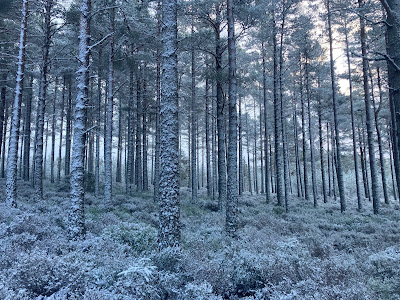 |
| A snowy Caledonian forest |
February 2022 bird sightings in more detail:
Up on the moors....
 |
| A local upland heather moorland |
 |
| Displaying Black Grouse |
Dawn in February (still a pretty user-friendly 7 am) on my safaris is usually spent visiting one (or more if needed!) local Black Grouse lek sites, usually a flat, grassy area on an upland heather moorland, where we often enjoy the spectacle of up to a dozen of these attractive, but sadly now increasingly rare, blue-black cock birds displaying, posturing aggressively and flutter-jumping in a bid to out-display and intimidate their opponents in a bid to secure their little patch of the 'arena' for the forthcoming breeding season, all accompanied by their distinctive bubbling and whooshing calls drifting across the moor... surely one of British wildlife's 'must-see' (and 'must hear') experiences? 'Performances' are usually noticeably better on cold, still mornings.... but please be aware that we have to view from a respectful (and legal) distance, and that sightings are not 'guaranteed' as the birds can fail to show for no apparent reason, as was the case on a few occasions this month...
 |
| Male Red Grouse |
Still on the moors, the cock Red Grouse are now becoming very territorial and full of aggression , as they defend their chosen 'territory' from rivals and try to attract a mate with much calling and posturing and their red eye wattles aglow, usually from one of the few higher vantage points, making them nice and easy for us to find!
Up in the glens...
 |
| A local upland glen |
 |
| Golden Eagle |
Golden Eagle and White-Tailed Eagle are nearly always on my safari clents' "wish-lists", and as I have said before, the shorter days of the winter months definitely give us the best chance of seeing them. That trend was continued this month, with several sightings of GE and a couple of WTE being achieved, though not as frequently as we had enjoyed in the 3-4 months before this...
 |
| Goshawk (photo from Feb 2021) |
 |
| Red Kite |
 |
| Common Buzzard |
Should the Eagles fail to show, the regular 'raptor back-up cast' of Kestrel, Sparrowhawk, Buzzard , Red Kite, and the chance of even the occasional Peregrine, Merlin, Hen Harrier or Goshawk often provide good entertainment by way of consolation though, and some of these species seemed to be performing courtship displays, another sign that breeding season will soon be upon us...
In the forests...
 |
| A snowy sunrise in a local Caledonian forest |
 |
| Crested Tit (photo from Feb 2016) |
Rather strangely, Crested Tits proved to be very elusive this month, with barely a sighting achieved, though thankfully, it wasn't just me, as guides from other safaris experienced the same disappointment, with the favourite theory as to why, being that the incredibly mild and spring-like weather in January may have made feeding stations less attractive, and prompted them to begin courtship and nesting season very early....
Generally though, it is well worth noting that the colder winter months (October-Feb) are actually the best time of year for seeing the 'wee Cresties', as these characterful little birds can be frustratingly secretive, unobtrusive and almost silent during the breeding season, with sightings being much more difficult to obtain between March and September....
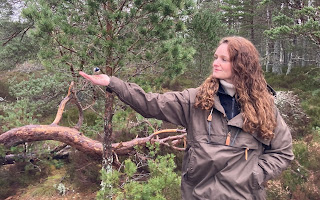 |
| Hand-feeding a Coal Tit in the Caledonian forest |
A bonus by-product of regular winter feeding is often (especially on colder days) being able to feed the incredibly confiding Coal Tits and (sometimes) Great Tits and Robin by hand, an experience much enjoyed by my safari clients of all ages...
 |
| Crossbill |
Still in the Caledonian forests, and similarly to last month, we actually did ok for Crossbill sightings again this month, with some decent views...mainly because the period between December and March is breeding season for them, which means that this is your best chance to see them perched in treetops, often singing to establish a territory and attract a mate....whereas they can be pretty tricky to see (apart from flyovers) for the rest of the year...
Despite numerous dawn walks in my local Caledonian forests again this month, sadly, I failed to see a single Capercaillie , though I did spot a few Caper poos, so there is still hope of a sighting in the future...
Please note that Capercaillie numbers would still appear to be declining alarmingly, they are now very rare and elusive, and I would only rate our chances of seeing one on my safaris as "very slim" at best...
On the rivers...
 |
| A typical local river |
 |
| Dipper |
Our Dippers are in full 'breeding season mode' now, and early morning visits to known favourite nesting sites (keeping a respectful distance of course) usually give us great views of these characterful and hardy little birds singing their hearts out, with wings back and chests pushed out... and towards the end of the month we often see one or two carrying nesting material....and it still makes me shiver every time I see these tough little birds submerge themselves when feeding in the freezing winter months...
We also occasionally see Goosander and Goldeneye on our local rivers too....
On the lochs...
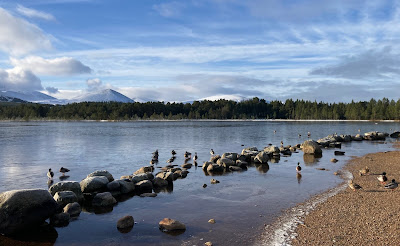 |
| A picturesque local loch |
 |
| Drake Goldeneye |
 |
| Whooper Swans |
Star birds on the lochs during the winter are probably the Goldeneyes, with the males now in their dapper breeding plumage and some displaying, and the winter-visiting Whooper Swans, with a back up cast of Goosander, Teal, Wigeon and Tufted Ducks.
On farmland....
 |
| Oystercatchers |
 |
| Curlew |
The first waders were seen returning to their spring/summer breeding grounds, with Oystercatcher, Lapwing, Golden Plover and Curlew all being noted.....
Up in the mountains....
 |
| The Cairngorm Mountains |
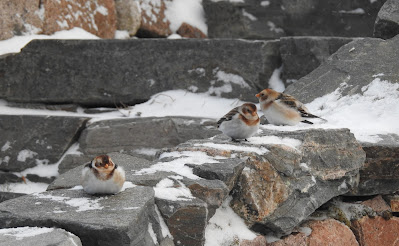 |
| Snow Buntings |
 |
| Snow Bunting close-up |
Snow Buntings can often be seen in and around the Cairngorms Ski Centre car park in the winter months, if it can be accessed in the often heavy snow and high winds, and that was the case on a few occasions this month, with up to 20 of these attractive and characterful little birds being seen. Their confiding nature means that you can sometimes creep reasonably close for photos too, especially if you put some wild bird seed out to attract and distract them....
With the Cairngorm Funicular Railway still closed for major repairs, and the days still quite short , I didn't venture up into the mountain-tops myself this month, but for future reference, a few Ptarmigan , still totally white, can sometimes be seen, up around the 'snow-line', usually sheltering in corries or on the leeward sides of ridges, out of the cold wind...
Winter-visiting birds seen in our area this month included:
 |
| Whooper Swans |
 |
| Brambling |
 |
| Waxwing |
 |
| Waxwing |
Whooper Swans, Grey Geese (Greylag , Pink-Footed and a few Barnacle), Redwings, Fieldfares, Bramblings , Redpolls, and a few Waxwings...
Other good/scarce birds seen/reported locally this month included:
The Great Grey Shrike lingered for just a couple of days at the start of the month, a Glaucous Gull was reported mid-month, and a few Hawfinches were seen on and off throughout the month...
A few photos of more common birds seen locally this month:
 |
| Greater-Spotted Woodpecker by Denis Thame |
 |
| Siskin |
 |
| Great Tit |
 |
| Red-Legged Partridges |
Adventures 'out of area':
 |
| Hopeman Bay on the picturesque Moray coast |
Snow Geese (with Greylag Geese)
 |
| 'Elvis' the King Eider |
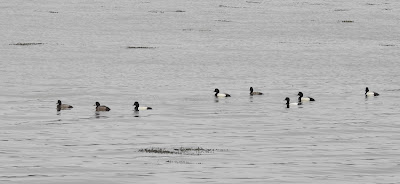 |
| Scaup |
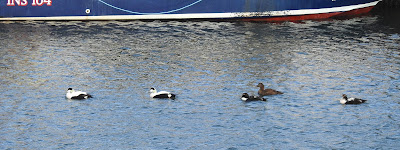 |
| Eiders |
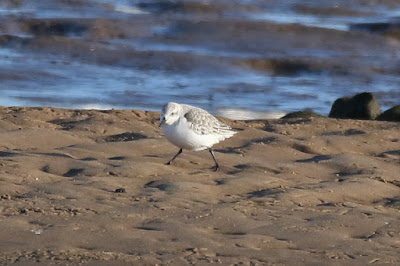 |
| Sanderling by Steve Nicklin |
 |
| Bar-Tailed Godwit by Steve Nicklin |
 |
| Red-Breasted Mergansers by Steve Nicklin |
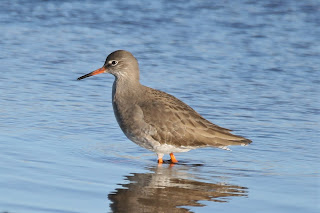 |
| Redshank by Steve Nicklin |
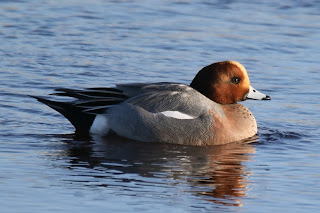 |
| Drake Wigeon by Steve Nicklin |
 |
| Drake Teal by Steve Nicklin |
 |
| Glaucous Gull by Steve Nicklin |
The Moray coast is only about a one hour drive north of Aviemore, and a couple of trips to favourite reserves, lochs, bays and harbours gave good views of wintering birds such as Greylag Geese, Pink-Footed Geese, Brent Geese, Barnacle Geese, Whooper Swan, Shoveler, Wigeon, Teal, Pintail, Bar-Tailed Godwit, Knot, Golden Plover , Grey Plover , Ringed Plover, Purple Sandpiper, Redshank, Oystercatcher, Turnstone, Curlew, Common Scoter, Velvet Scoter, Long-Tailed Ducks, Eiders, Red-Throated Diver, and Slavonian Grebe, with the chance of scarce birds such as Tree Sparrow, and rarities such as Snow Geese, rare Scoters, rare Gulls, and King Eider.....
February 2022 mammal sightings in more detail:
 |
| Mountain Hare |
Our local Mountain Hares usually 'steal the show' this month, and it is very hard to argue against that when you take into account their gorgeous looks in their winter white coats, their relative scarcity in the UK, and the often spectacularly scenic upland habitat in which they are found.
However, in contrast to the snowless conditions of last month, the all white backgrounds this month made their camouflage very effective, and we often struggled to find them...
It should also be noted , that most of our views are at range through my telescope, and that a closer view usually involves some considerable amount of rough uphill walking, often on snow.
 |
| Red Deer stags |
Still up in the glens, large same-sex herds of Red Deer can often be seen well, but only if you used a bit of fieldcraft, and concentrated on looking for them on the leeward side of the hills, as although they are pretty hardy animals, they are clearly sensible enough not to stay exposed to strong winds or blizzards, of which we had plenty this month!
 |
| Feral Mountain Goats |
Also sharing the same upland habitat are our local Feral Mountain Goats, and we did pretty well this month, seeing them on most occasions that we visited the glens where they live, and although they seemed keen to keep their distance, we noted that there were now some very cute recently born youngsters among them...
In our local Caledonian forests, Red Squirrels always put big smiles on my safari clients faces, with many of them seeing these rare, cute and characterful little animals for the first time. Although most of our sightings are at feeding stations - they love peanuts! - we also had plenty of 'chance' sightings of them whilst driving or walking along the quieter forest tracks...
Roe Deer (photo from Feb 2019)
Roe Deer however, can be a little trickier to see, being more wary of human disturbance, and most of our sightings were at dawn or in very quiet or remote areas, and were usually of the 'brief' variety, as they ran away on becoming aware of us...
 |
| Brown Hare (photo from Feb 2021) |
Brown Hares have proved very elusive for me so far this year, and I'm not sure I can recall a solitary decent sighting of one this month
 |
| Carrot time for Murdo |
Hairy Highland Coo's always prove to be popular with my safari clients, especially those who do not have them close to home, so don't be afraid to ask me if you fancy going to see them, and maybe even get to feed and 'pat' them, as I have a couple of great sites....
Rare/nocturnal mammals:
I get a few enquiries about the possibility of seeing Badgers and Pine Marten from my safari clients, many of whom I suspect are unaware that they are actually a largely nocturnal creature, and although we do get the occasional (maybe one or two a year) dawn glimpse of one, you would definitely have a much higher chance of seeing them at a specific dusk Badger/Pine Marten watching hide - Please contact me for more information.
Similarly, our inland Otters too are mainly active during the hours of darkness, and again, although we do get a few early-morning sightings on local lochs and rivers each year, looking for them feeding in a suitably quiet, kelp - filled bay on the coast on a rising tide, but at any time of day, would give you a much better chance.
Whilst we are still on the 'tricky to see stuff', the Scottish Wildcat too, as well as being incredibly rare now, is also generally nocturnal, and the fact that I have had a mere handful of (dawn or dusk) sightings in 17 years of providing wildlife safaris should give you an idea of how difficult they are to see.
Other wildlife:
Nothing to report in this category this month, I'm afraid....
 |
| The first brave Snowdrops have emerged |
News:
The BIG news is that all tourism/hospitality/activities in Scotland are open , are now largely free of restrictions except for the 1 metre social distancing recommendation, and that I have now completed ten (thankfully!) increasingly busy and extremely enjoyable full months of safaris with clients with no major issues arising.
With all national travel restrictions lifted too, Scotland is officially 'open for business' for visitors from all over the UK, and from abroad.
At the time of writing, due to COVID distancing rules, and as restrictions have only recently been relaxed, we are still operating at reduced capacity, and are still trying not to mix unconnected groups unless this is unavoidable, so we are currently recommending 'exclusive' safaris, at a small extra cost.
For those considering a visit, these wildlife/outdoor tourism websites may prove useful:
https://www.gov.scot/collections/coronavirus-covid
NatureScot (outdooraccess-scotland.scot)
Can Nature Help Health? | Nature Prescriptions - YouTube
Scotland, Yours to Enjoy. Responsibly. - YouTube
Cairngorms National Park Authority
 |
| A walk in the ancient Caledonian forest |
 |
| A snowy scene on a local upland river |
Summary:
Well, despite the often wild and wintry weather turning many of our safaris this month into a bit of an 'adventure', I certainly relished braving the elements, as did most of my safari clients, and on reflecting on my notes and photos whilst compiling this report, considering the conditions, I reckon we actually did pretty well for wildlife sightings too, with plenty of upland and local speciality birds and animals seen, though I have to say that I won't complain if the weather was to calm down and turn a little more spring-like soon...
 |
| The 18th century packhorse bridge at Carrbridge |
Reviews:
https://www.tripadvisor.co.uk/Attraction_Review-g186537-d3335134-Reviews-
Buying my photos:
Prints of any of the photos (taken by myself) shown on this blog, going right back to 2015, reproduced on high quality photographic paper, with a choice of sizes up to A3, and satin pearl or glossy finishes available, can now be purchased from me at very reasonable prices. So if you see an image that might look nice in a frame (provided by yourself) on your wall, please make a note of the year and month of my blog in which it appeared, and email me for more information.
 |
| Safari gift voucher |










No comments:
Post a Comment